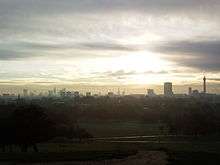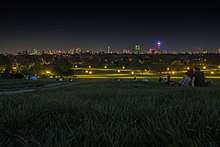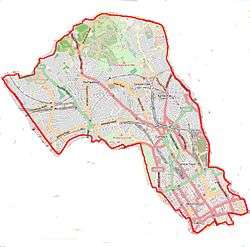Primrose Hill
| Primrose Hill | |
|---|---|
 View of central London from Primrose Hill | |
 Primrose Hill Primrose Hill shown within Greater London | |
| OS grid reference | TQ282838 |
| London borough | |
| Ceremonial county | Greater London |
| Region | |
| Country | England |
| Sovereign state | United Kingdom |
| Post town | LONDON |
| Postcode district | NW1, NW3, NW8 |
| Dialling code | 020 |
| EU Parliament | London |
| UK Parliament | |
| London Assembly | |
Primrose Hill is a hill of 213 feet (65 m)[1] located on the northern side of Regent's Park in London. The name was given also to the surrounding district. The hill summit has a clear view of central London, as well as Hampstead and Belsize Park to the north and is adorned by an engraved quotation from William Blake. Nowadays it is one of the most exclusive and expensive residential areas in London and is home to many prominent residents.[2]
The Primrose Hill district is surrounded by the affluent areas of St John's Wood to the west, Swiss Cottage to the northwest, Belsize Park to the north, Chalk Farm to the northeast, Camden Town to the east and Regent's Park itself lies adjacent to the south of the hill itself. The nearest stations to Primrose Hill are Chalk Farm tube station to the northeast and Swiss Cottage tube station to the northwest. The defunct Primrose Hill railway station sits on the railway lines that separate the Primrose Hill area from Camden Town.
Amenities of the hill include an outdoor gym known as the Hill Trim Trail, a children's playground, and toilets, all located on the south side near Primrose Hill bridge which connects to London Zoo and Regent's Park.
The park is Grade II listed.[3]
History


Like Regent's Park, Primrose Hill was once part of a great chase appropriated by Henry VIII. Later, in 1841, it became Crown property and in 1842 an Act of Parliament secured the land as public open space. The built-up part of Primrose Hill comprises mainly Victorian terraces; the name Primrose Hill has been in use since the 15th century - giving the lie to later claims that it was named after Archibald Primrose, whose premiership witnessed the rapid expansion of London underground rail network London.[4]
It has always been one of the more fashionable districts in the urban belt that lies between the core of London and the outer suburbs, and remains expensive and prosperous. Primrose Hill is an archetypal example of a successful London urban village, due to the location and the quality of its socio-historical development.[5]
In October 1678, Primrose Hill was the scene of the mysterious murder of Edmund Berry Godfrey (Greenberry Hill).[6] In 1792 the radical Unitarian poet and antiquarian Iolo Morganwg (Edward Williams) founded the Gorsedd, a community of Welsh bards, at a ceremony on 21 June at Primrose Hill.
Famous graffiti
There is, as in most places in London, graffiti on Primrose Hill. However, the one that seemed to impact the public most was a lyric about Primrose Hill by the band Blur (from their single "For Tomorrow"). The graffiti read 'And the view's so nice' until it was removed in 2012. Some have tried to restore it, but none have yet succeeded.
Notable buildings and residents
There are seven English Heritage blue plaques in Primrose Hill commemorating the historic personalities that have lived there.[7] The plaques mark the residences of poet Sir Hugh Clough, historian and broadcaster A. J. P. Taylor and painter William Roberts at 11, 13, and 14 St Mark's Crescent respectively, revolutionary socialist and philosopher Friedrich Engels at 122 Regent's Park Road, photographer Roger Fenton at 2 Albert Terrace, poet and novelist Sylvia Plath at 3 Chalcot Square, and poet William Butler Yeats at 23 Fitzroy Road.[7]
Stanley Johnson and Lukas Heller each lived at different times at the 'Rocking Horse House' on Regent's Park Road. [8] Joan Bakewell also lives in the area.[9]
During the 1990s Primrose Hill was popular place to live with some who worked the film, music and fashion industries and who were referred to as the Primrose Hill set in British newspapers.[10]
See also
References
- ↑ Mills, A., Dictionary of London Place Names, (2001)
- ↑ Knight Frank & Rutley, Londons Top 10 Expensive Areas 2011
- ↑ Historic England, "Primrose Hill (1001526)", National Heritage List for England, retrieved 18 June 2017
- ↑ "London Rubble: How The City's Soil Gets Recycled". Londonist. Retrieved 2017-06-11.
- ↑ Barr, Alistair, Primrose Hill, An Urban Village Examined Archived 22 July 2007 at the Wayback Machine.
- ↑ "'Sir Edmund Berry Godfrey's Murder Made Visible', contemporary pamphlet, 1678". PBS LearningMedia.
- 1 2 "Search Blue Plaques". Blue plaques search – Primrose Hill. English Heritage. Retrieved 6 September 2014.
- ↑ Ivey, Prudence. "Property Local landmark: former Johnson family home, the legendary 'Rocking Horse House' in Primrose Hill, for sale for £11.25m". Evening Standard.
- ↑ "Joan Bakewell: 'Life is short, so get your values sorted' - Entertainment - Hampstead & Highgate Express - Broadway". Hamhigh.co.uk. 2015-10-11. Retrieved 2017-06-11.
- ↑ Craik, Laura (1 June 2015), "Primrose Hill: the NW1 set has lost its cool", Evening Standard
External links
| Wikimedia Commons has media related to Primrose Hill. |
- Primrose Hill – An Urban Village Examined by Alistair Barr, Architect & Resident (Barr Gazetas)
- Article on Primrose Hill Farmers' markets
- Primrose Hill Local Website
- Primrose Hill and Regent's Park in Literature and Music, a bibliography

